The author of "A Pattern Language" and "Notes on the Synthesis of Form" had an outsize influence far beyond architecture and urbanism—and still does.
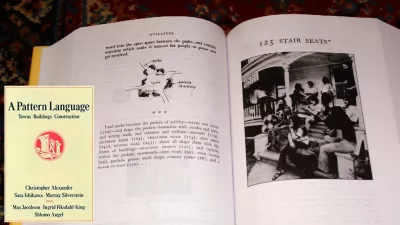
This week came news of the passing of Christopher Alexander, widely described as one of the most influential architects and urbanists of the last half-century. Robert Campbell, the Pulitzer Prize-winning architecture critic for the Boston Globe, probably spoke for many when he observed that Alexander "had an enormous, critical influence on my life and work, and I think that's true of a whole generation of people.”
Certainly, a remarkably diverse group of architects, urban planners and researchers claims to have been influenced by Alexander, including Rem Koolhaas, Andrés Duany, Bill Hillier, and many more. Many other widely known theorists and authors were influenced by him too, including Stewart Brand, author of How Buildings Learn: What Happens After They’re Built, and The Whole Earth Catalog.
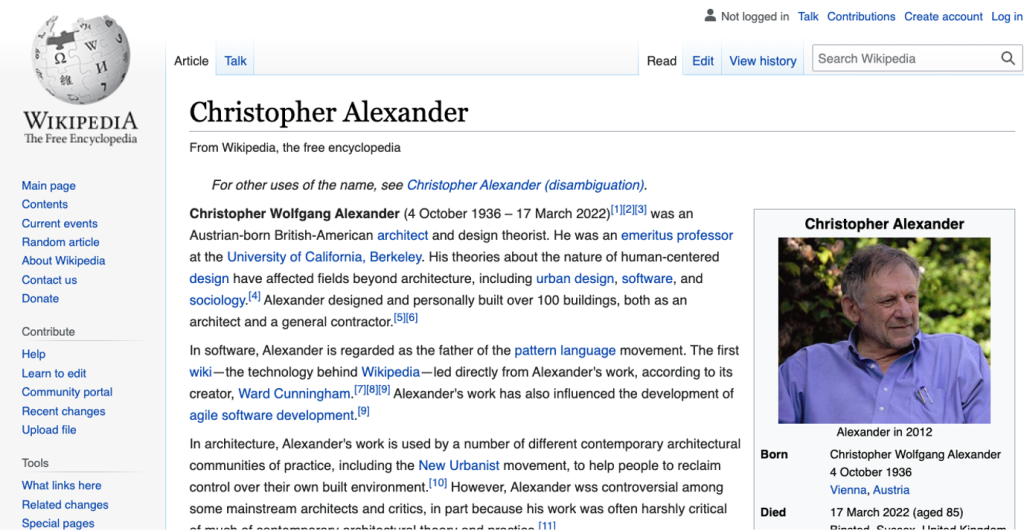
Alexander’s influence also extended far beyond architecture and urbanism. Ward Cunningham, inventor of wiki (the technology behind Wikipedia), credits Alexander with directly inspiring that innovation, as well as pattern languages of programming, and the even more widespread Agile methodology. Will Wright, creator of the popular games Sim City and The Sims, also credits Alexander as a major influence, as do the musicians Brian Eno and Peter Gabriel. Apple’s Steve Jobs was also said to be a fan.
Moreover, one can also find direct applications of Alexander’s pattern language methodology in product design, engineering, anthropology, sociology, biology, and many other fields. In fact, the chances are that every day, you are using—in your iPhone, on your computer, when you use Wikipedia or Google, or in countless other ways—some form of Alexander-inspired technology.
What is it about Alexander’s work that has made it so useful for all these fields? Moreover, what does his work say about where we are today in urbanism and architecture, and in design and technology more broadly—and where we need to go?
Most people who know Alexander’s work are most familiar with his 1977 book (written with six student co-authors), A Pattern Language: Towns, Buildings, Construction. For many people, this “pattern language” methodology offered a very helpful and appealing tool to help to organize a design process, and moreover, to create a web-like interrelation between the elements of a design. But there was a deeper set of ideas behind this methodology—one that many people found to be revolutionary and inspirational.
For Alexander, we’ve been getting some things very wrong—most centrally in our approach to the relationship between technology and life. In fact, we’ve embraced a deathly form of technology, one that is killing the planet, and certainly killing human habitats. (That goes for financial technology as well as planning and design technology, in addition to other kinds of technology.) The core problem is that we have failed to understand the living processes going on all around us, and instead of supporting them, our more mechanically oriented technology is destroying them. This need not be so, however, if we understand the kinds of mistakes we are making today.
Alexander made a contrast with the remarkably robust and beautiful structures of past societies. Whatever their faults, we can see that there was some kind of “unself-conscious process” at work in creating the richness and beauty of these cultures, and we can learn much from that process. Indeed, it is now critical that we recapture this life-supporting process, albeit in a necessarily more self-conscious form. Our goal now must be to recapture a “timeless way of building”—and a timeless kind of technology that is more supportive of life.
Alexander believed that a "timeless way of building" is not some mystical subject—it’s an entirely logical and comprehensible goal. This belief arose in large part from his rigorous education in mathematics, physics, and other sciences at the University of Cambridge, prior to his studies in architecture at Harvard (where he earned its first PhD in the subject). The scientist in him saw an objective structural relationship—one that we’ve been getting wrong, and that we can begin to understand better, for example, when we look at biological systems. This is the fundamental relationship between parts and wholes—the ancient topic that philosophers call “mereology.”
The places we love, the places that are most successful and most alive, have a wholeness about them that is lacking in too many contemporary environments, Alexander observed. This problem stems, he thought, from a deep misconception of what design really is, and what planning is. It is not “creating from nothing”—or from our own mental abstractions—but rather, transforming existing wholes into new ones, and using our mental processes and our abstractions to guide this natural life-supporting process.
Alexander referred a number of times to the work of the philosopher Alfred North Whitehead. “The final conclusion,” said Whitehead, summing up the arguments in his remarkable 1938 book Modes of Thought, “is the importance of a right adjustment of the process of abstraction… The higher animals are distinguished from mere life, by their abstractions, and by their use of them. Mankind is distinguished from animal life by its emphasis on abstractions. The degeneracy of mankind is distinguished from its uprise by the dominance of chill abstractions, divorced from aesthetic content.”
Or, we may say, the aesthetic content is now provided largely by those “chill abstractions” themselves. We are lost in a kind of “hall of mirrors” of our own abstractions and their constructions, divorced from life—from wholeness, from health, and ultimately from sustainability. This need not be, but to correct the problem, we will need “a right adjustment of the process of abstraction.”
Alexander noted that we think of parts as discrete things that are put together into our own compositions to “make” a whole. But this is not how nature works, says Alexander—or how human nature works at its best. In nature, the leaves don’t “make” a tree. In fact, the tree makes the leaves! There is a constant process of adaptive differentiation, and this process gives rise to new forms, through a process of morphogenesis. This is going on all the time in healthy structures, and healthy environments. We as planners and architects can either learn to support this kind of process, and support life, or we can choke it off, and create dead places. According to Alexander, we have been doing the latter too much.
In part, the trouble lies in the conception of physical space as something that is inert, lifeless, and a kind of “empty place.” But Alexander found ample evidence from physics, biology, and other fields (and once again from Whitehead) that space may have an inherent capacity for a kind of primordial life, and a capacity for degrees of life—depending wholly on the structures that occur within it. After all, the structures of biological life have a particular spatial relationship or order, and that is what gives rise to their aliveness: the molecules that make up genetic codes, or proteins, or neurons. That particular spatial structure, with its interconnected network relationships, is integral to the capacity for life: the life of the genome, of the proteome, or of the brain’s “connectome.”
So too with cities, Alexander found. “Natural” cities had a characteristic overlapping web-network structure, which emerged as a spontaneous geometric outcome of their living processes. This was the central point of his landmark 1965 paper, “A City is Not a Tree.” These “overlaps” could be mundane—an example he gives in the paper is of a simple sidewalk, a crosswalk light, and a newspaper rack, But these seemingly simple elements form a complex interactive network system—rather like the “Rock, Paper, Scissors” game. By contrast, planners had been rationally sorting cities into neat, tree-like geometric forms, with profoundly negative consequences for the life of the city. In the paper, he wrote:
“It must be emphasised, lest the orderly mind shrink in horror from anything that is not clearly articulated and categorised in tree form, that the ideas of overlap, ambiguity, multiplicity of aspect, and the semilattice, are not less orderly than the rigid tree, but more so. They represent a thicker, tougher, more subtle and more complex view of structure.”
Alexander concluded:
“For the human mind, the tree is the easiest vehicle for complex thoughts. But the city is not, cannot and must not be a tree. The city is a receptacle for life. If the receptacle severs the overlap of the strands of life within it, because it is a tree, it will be like a bowl full of razor blades on edge, ready to cut up whatever is entrusted to it. In such a receptacle life will be cut to pieces. If we make cities which are trees, they will cut our life within to pieces.”

Alexander concluded that the life of the city—and life in any form—relied essentially on the geometric structures in space that were generated through these living processes, including human ones. If we didn’t understand this, and if our plans made this generation of living structures impossible, then we were likely to create dead or dying places. And so we were.
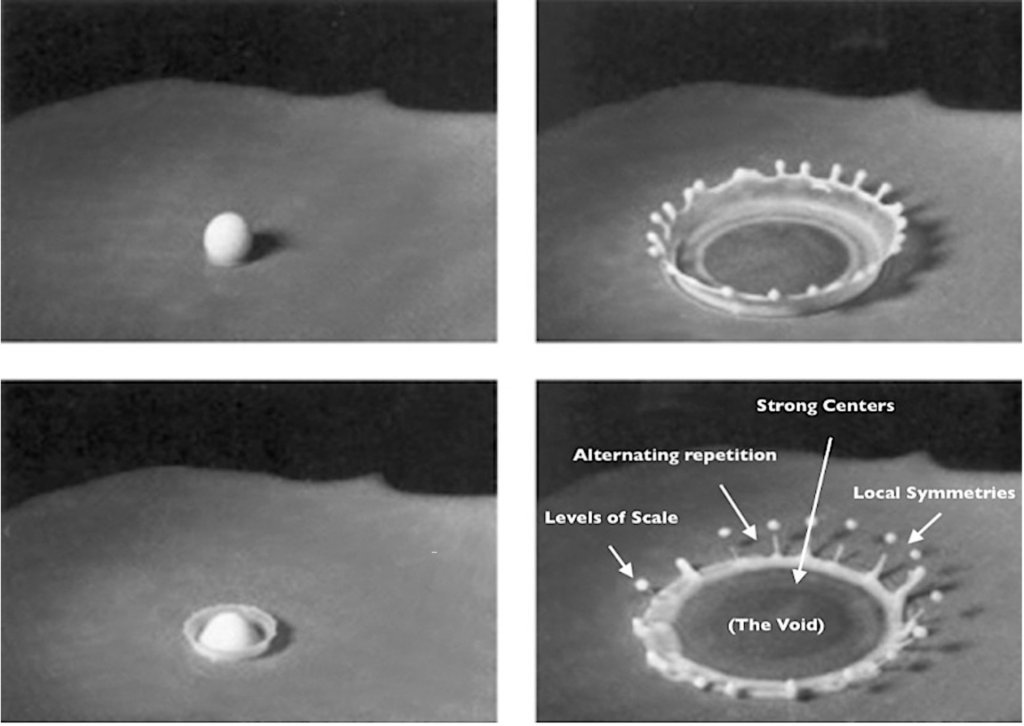
Alexander developed his theory of life in space in his last major work, the four-volume The Nature of Order. He observed that the processes that occur in space create characteristic geometries of life, including the complex patterns and symmetries that we all know and experience as beautiful. These are not just arbitrary aesthetic experiences, Alexander believed: they are manifestations of the profound order of living structures, and of a Universe that must itself be in some sense alive. In the case of cities and neighborhoods, these structures are essential to our well-being, our health, and even our capacity to survive.
Alexander noted that the natural processes going on all around us tend to generate certain geometric properties—centers, borders, levels of scale, alternating repetition, and other characteristic patterns. It isn’t an accident that the most beautiful human constructions also contain these same geometric properties, for they are also generated from the human processes of craft and adaptation—a “timeless way of building,” producing a recognizable (and precious) “quality without a name.”
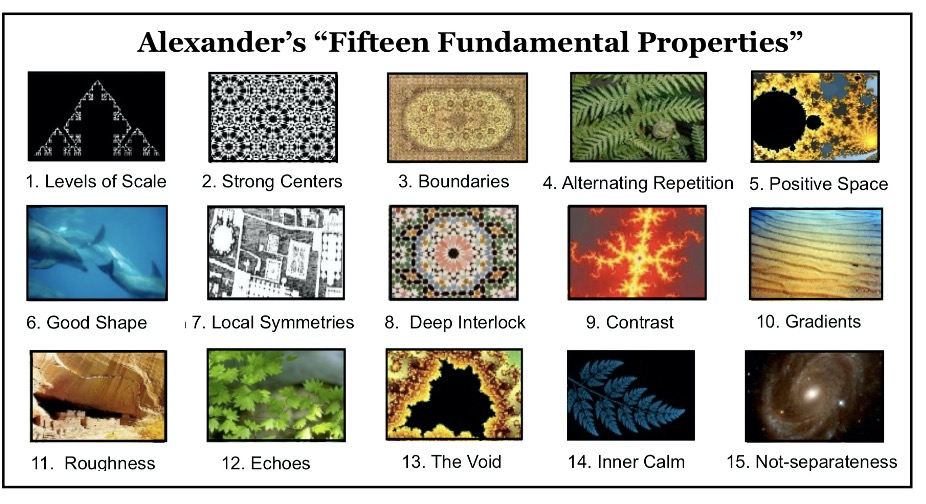
Nor is it an accident that many contemporary environments are denuded of these same properties, owing to the lifeless mechanical ways that they are produced (in spite of the glamorous artistic packaging often added to them). But this geometric poverty—this “symmetry deficit disorder,” as my colleague Nikos Salingaros and I have come to call it—has measurably negative impacts on our health, our well-being, and very likely, the sustainability of our world.
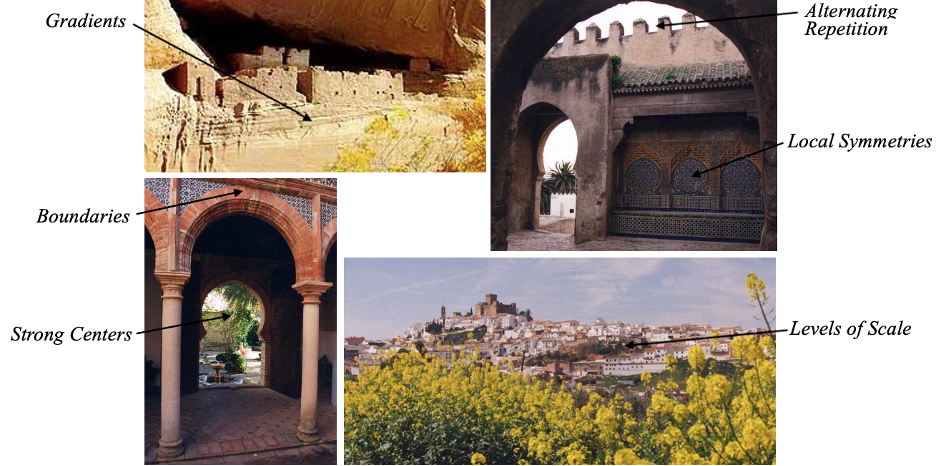
Alexander certainly had his share of critics, notably including some star architects. They often dismissed him—often from a position of philosophical illiteracy—as a kind of irrelevant Romantic or Luddite. Perhaps worse, he was a critic who dared challenge the legitimacy of their own proud regime. For them, the modern era has been the pinnacle of human civilization, to be manifested and celebrated in its architecture—a time of great achievements in human rights, advancements in medicine and sanitation, and development of powerful stripped-down and sanitized technologies that made life safer and more comfortable.
No doubt all that is true, up to a point, and Alexander would not disagree. But it is also true that this advancement has come at a potentially catastrophic cost, leaving us today in a post-modern period where all our advancements count for little if we can’t learn now to sustain the life around us.
And we can’t do that if we are paralyzed by postmodern theories of culture and life, where little matters other than the relativistic whims of social construction. That is not how reality works, said Alexander: rather, it is simply a state of confusion, borne of our misuse of abstractions. And those in its grip are, not surprisingly, often paralyzed by cynicism and nihilism. As Jane Jacobs memorably put it, speaking of modern city planners: “[Their work] lacks the first requisite for a body of practical and progressing thought: recognition of the kind of problem at issue. Lacking this, it has found the shortest distance to a dead end.”
By comparison, Alexander emerges as an intelligent optimist: able to see a path forward, into a more hopeful future. And judging by the remarkable contributions already made, and the many tangible spinoff benefits, we can reasonably expect—given the thousands of people inspired by Alexander, and continuing his many fruitful lines of work—more hopeful results to come.
Michael Mehaffy is a former student and long-time colleague of Christopher Alexander, and a scholar on his work. He is also Executive Director of the Sustasis Foundation, which recently completed a documentary film about Alexander’s work. He is also lead organizer of the International Making Cities Livable conference series. Their May 18-22 conference in Paris will feature a celebration of Alexander’s life and work.

Pennsylvania Mall Conversion Bill Passes House
If passed, the bill would promote the adaptive reuse of defunct commercial buildings.

World's Largest Wildlife Overpass In the Works in Los Angeles County
Caltrans will soon close half of the 101 Freeway in order to continue construction of the Wallis Annenberg Wildlife Crossing near Agoura Hills in Los Angeles County.

U.S. Supreme Court: California's Impact Fees May Violate Takings Clause
A California property owner took El Dorado County to state court after paying a traffic impact fee he felt was exorbitant. He lost in trial court, appellate court, and the California Supreme Court denied review. Then the U.S. Supreme Court acted.

California Grid Runs on 100% Renewable Energy for Over 9 Hours
The state’s energy grid was entirely powered by clean energy for some portion of the day on 37 out of the last 45 days.

New Forecasting Tool Aims to Reduce Heat-Related Deaths
Two federal agencies launched a new, easy-to-use, color-coded heat warning system that combines meteorological and medical risk factors.

AI Traffic Management Comes to Dallas-Fort Worth
Several Texas cities are using an AI-powered platform called NoTraffic to help manage traffic signals to increase safety and improve traffic flow.
City of Costa Mesa
Licking County
Barrett Planning Group LLC
HUD's Office of Policy Development and Research
Mpact Transit + Community
HUD's Office of Policy Development and Research
Tufts University, Department of Urban and Environmental Policy & Planning
City of Universal City TX
ULI Northwest Arkansas
Write for Planetizen
Urban Design for Planners 1: Software Tools
This six-course series explores essential urban design concepts using open source software and equips planners with the tools they need to participate fully in the urban design process.
Planning for Universal Design
Learn the tools for implementing Universal Design in planning regulations.

























